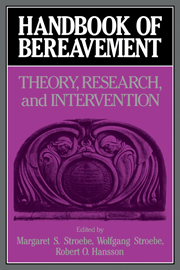Book contents
- Frontmatter
- Contents
- Contributors
- Preface
- Part I Introduction
- Part II The phenomenology and measurement of grief
- Part III Current theories of grief, mourning, and bereavement
- Part IV Physiological changes following bereavement
- 9 Biobehavioral consequences of loss in nonhuman primates: Individual differences
- 10 Neuroendocrine changes following bereavement
- 11 Bereavement, depressive symptoms, and immune function
- Part V The psychological, social, and health impacts of conjugal bereavement
- Part VI Grief reactions to different types of loss
- Part VII Coping, counseling, and therapy
- Part VIII Conclusions
- References
- Author index
- Subject Index
11 - Bereavement, depressive symptoms, and immune function
Published online by Cambridge University Press: 04 May 2010
- Frontmatter
- Contents
- Contributors
- Preface
- Part I Introduction
- Part II The phenomenology and measurement of grief
- Part III Current theories of grief, mourning, and bereavement
- Part IV Physiological changes following bereavement
- 9 Biobehavioral consequences of loss in nonhuman primates: Individual differences
- 10 Neuroendocrine changes following bereavement
- 11 Bereavement, depressive symptoms, and immune function
- Part V The psychological, social, and health impacts of conjugal bereavement
- Part VI Grief reactions to different types of loss
- Part VII Coping, counseling, and therapy
- Part VIII Conclusions
- References
- Author index
- Subject Index
Summary
This chapter reviews the clinical studies that have found alterations of immune function in spousal bereavement, suggesting that individual psychological responses such as depressive symptoms may mediate changes in cellular immunity. In addition, the role of activation of either the pituitaryadrenal axis or the sympathetic nervous system to produce changes in immunity during bereavement is discussed. To facilitate a clearer understanding of the work linking bereavement and changes in immune function, a brief overview of the immune system, including a discussion of the relevance of immune measures to changes in health, is presented.
Overview of the immune system
The immune system functions to discriminate “self” from “nonself” cells, protecting the organism from invasion by pathogens such as viruses and bacteria or from abnormal internal cells such as cancer cells (Hood, Weisman, Wood, & Wilson, 1985; Cohn, 1985). These functions are closely regulated and performed without damage to the host, although an overresponsive immune system is purported to lead to autoimmune disease in which the organism's own tissues are attacked (Cohn, 1985; Morimoto et al., 1987; Talal, 1980; Paul, 1984).
The organs of the mammalian immune system are the thymus, spleen, and lymph nodes (Hood et al., 1985; Paul, 1984). The working cells of the immune system are represented by three distinct populations: T cells, B cells, and natural killer, or NK, cells (Paul, 1984; Hood et al., 1985; Ritz, 1989). Immune responses can be divided into two important components: cellular immunity and humoral responses (Nossal, 1987; Gilliland, 1983; Paul, 1984).
- Type
- Chapter
- Information
- Handbook of BereavementTheory, Research, and Intervention, pp. 160 - 172Publisher: Cambridge University PressPrint publication year: 1993
- 10
- Cited by



